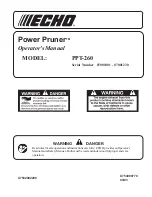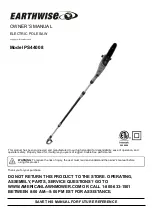
E N G L I S H
en - 6
20
• Follow the horizontal intersecting line to either side to get the mitre
angle setting on the saw (23°).
• Likewise follow the vertical intersecting line to the top or bottom to get
the bevel angle setting on the saw (40°).
• Always try cuts on a few scrap pieces of wood to verify the settings on
the saw.
Cutting non-ferrous metals
When cutting non-ferrous metals, the machine is only to be used to
perform vertical straight and mitre cross-cuts in the mitre saw mode.
We recommend that bevel and compound mitre cuts should not be
performed in non-ferrous metals. The machine is not to be used for cutting
ferrous metals.
• Always use a material clamp when cutting non-ferrous metals.
Make sure that the workpiece is clamped securely.
• Only apply saw blades that are qualified for cutting non-ferrous metals.
• When using lubricants, only apply wax or separation spray. Do not use
emulsions or similar fluids.
• Connect an FI or DI switch between machine and mains to avoid
residual risks caused by metal swarf.
The FI switch should comply with the following specifications:
rated voltage
230 V
rated current
16 A
reaction time
< 15 ms
fusing current
30 mA
The DI switch should comply with the following specifications:
DIN VDE 0661
rated voltage
230 V
rated current
16 A
fusing current
30 mA
all-pole cutoff
L+N+PE
PE monitoring
low-voltage release
0
5
10
15
20
25
30
35
40
45
0
5
10
15
20
25
30
35
40
45
5
10
15
20
25
30
35
40
45
5
10
15
20
25
30
35
40
5
10
15
20
25
30
35
40
45
50
55
60
65
70
75
80
85
5
10
15
20
25
30
35
40
45
50
55
60
65
70
75
80
85
5
10
15
20
25
30
35
40
45
50
55
60
65
70
75
80
85
SET THIS BEVEL ANGLE ON SAW
SET THIS MITER ANGLE ON SAW
ANGLE OF SIDE OF BOX (ANGLE"A")
SQUARE BOX
6 SIDED BOX
8 SIDED BOX
Optional Accessories
Dust extraction
A dust extraction kit DE7777 consisting of 3 hoses, a 3-way connector,
and the required fixing material is available for optimal dust extraction.
Clamping the workpiece (fig. A3)
Always use a material clamp when cutting non-ferrous metals.
• In most cases, the action of the blade is sufficient to hold the material
firmly against the fence.
• If the material has a tendency to lift or come forward from the fence,
preferably use the optional material clamp (28).
Sawing short workpieces (fig. A3)
It is advisable to use the length stop for short workpieces (32) both for
batch sawing and for short individual workpieces of different lengths.
The length stop can only be used in conjunction with a pair of optional
guide rails (26).
Sawing long workpieces (fig. A3)
Always support long workpieces.
Figure A3 shows the ideal configuration for sawing long workpieces when
the saw is used free-standing (all items available as an option). These
items (except the legstand and the material clamp) are required both on
the infeed and the outfeed side:
- Legstand (31) (supplied with mounting instructions).
- Guide rails (500 or 1,000 mm) (26).
- Stands (30) to support the guide rails. Do not use the stands to
support the machine! The height of the stands is adjustable.
- Material support plates (27).
- Table end plate (25) for supporting the rails (also when working on an
existing bench).
- Material clamp (28).
- Swivelling stop (29).
• Place your saw on the legstand and fit the guide rails.
• Firmly screw the material support plates (27) to the guide rails (26).
The material clamp (28) now functions as a length stop.
• Install the table end plates (25).
• Install the swivelling stop (29) to the rear rail.
• Use the swivelling stop (29) to adjust the length of medium and long
workpieces. It can be adjusted sideways or swung out of the way
when not in use.
Using the roller table (fig. A3 & A5)
The roller table (33) makes the handling of large and long pieces of wood
very easy (fig. A5). It can be connected either to the left or to the right of
the machine. The roller table requires the use of the optional legstand (fig. A3).
Assemble the roller table following the instructions supplied
with the legstand.
• Replace the short support bars provided with the legstand with the
irregular rails from the table on the side the table is to be used.
• Follow all instructions provided with the roller table.
















































